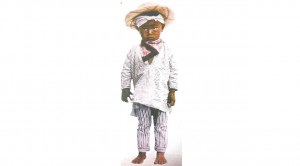
(Part I)
George Ade’s “Stories of Benevolent Assimilation (of the Philippines)” originally appeared in the Chicago Record once a week, from July 8 to Oct. 18, 1899, until collected in book form.
George Ade was anti-imperialist like Mark Twain (who was passionate and sarcastic in his comments). George Ade, on the other hand, was “superior and amused,” “pricking the pretentions of the expansionists.”
Since we are again negotiating with our now-friend, the US, concerning the bases, I recalled George Ade. I decided to reproduce a few stories in his book. The main character, a missionary, Washington Conner, traveling representative of the United States of America, explains in this one Western habiliments to a Filipino family.
Introduced in a preceding story were: the Filipino father, Bulolo Kakyak, his wife, Luna, sons Francisco and Patricio, and daughter, Eulalie (18 years old).
Dressing instructions
On his arrival, Washington Conner went back to the railway station, four miles away, and brought up his heavy baggage. The large trunks filled a wagon, which was creakingly pulled by two downcast water buffaloes. The wagon crawled an avenue of palms and stopped in front of the Kakyak house. The American missionary, who was straddling the topmost Saratoga, waved at the Kakyak family and announced, “Samples of civilization! Wait until you see what I have in these trunks.”
“Do you need so many?” asked Mr. Bulolo Kakyak. “What’s in them?”
“In these trunks,” said Mr. Conner, “are a great many articles that will give you some idea of the civilization which it is your duty to adopt. Mrs. Kakyak and Eulalie will be particularly interested.”
“They’re large!” said the daughter.
“If you are going to be a civilized young woman, Eulalie, you must make up your mind to carry several large trunks with you when you travel. You can usually measure a person’s moral and intellectual worth by the amount of luggage he takes on a trip. For instance, the English tourist, who is the most civilized on earth, usually carries several hatboxes, a bundle of sticks and a portable bathtub in addition to his trunks and Gladstone bags.”
The trunks were unloaded as Mr. Conner stood by, nervously giving directions. After the trunks were tumbled to the ground they were dragged, one by one, into the house.
“Mr. Kakyak, you and the boys may go to your work in the fields,” said Conner. “My instruction for today will concern only Mrs. Kakyak and Eulalie. I want to exhibit to them the wearing apparel of our great republic and give them some idea of the costumes that they will be expected to wear when they have been assimilated.”
“Are the garments worn in your country so much different from ours?” asked Eulalie, eyes sparkling.
“Oh, decidedly so,” replied Conner with a smile of superior wisdom. “Why, Eulalie, you are now a young lady, old enough to dream of matrimony; yet I find you bareheaded and barelegged. A young lady should never be barelegged except at the seashore. And your skirt, I am compelled to say, is outrageously short unless you intend to ride a bike.”
“A bike?” inquired Mrs. Kakyak.
“Truly enough the island of Luzon is in a benighted state,” said Conner, looking at Mrs. Kakyak and shaking his head. “Later I will explain to you what a bike is. For the present, I will concentrate on the subject of wearing apparel.
“The proper thing for a girl is never to appear in public places barelegged and with her garments hanging loosely about her person. And look at Eulalie there. Notice how carelessly she exposes one of her shoulders.”
“I didn’t know it was improper,” said Eulalie in a shamed whisper, as she attempted to lift the loose shirtwaist (kimona) over the little brown shoulder.
“It is improper,” said Mr. Conner. “After you become civilized, you may display both shoulders, but not one at a time. I say you may display both shoulders, but not at all times, understand?”
“Yes?” questioned Eulalie, greatly interested.
“You must never make a display of your bare shoulders except in the evening. That’s one of the unchangeable laws of our higher civilization. If you were to appear in the morning in a costume which did not fully cover your shoulders you would be regarded as a shameless hussy and banished from polite circles for all time.”
“But in the evening it is all right?” said Eulalie, puzzled.
“In the evening it is more than all right—it is the only correct thing to do.”
“Yes, why should there be any difference?” chimed in Mrs. Kakyak.
“There are reasons, ladies,” said Conner, “but I am not sure that they would appeal to your primitive understanding. Please don’t expect me to tell the reason for anything. Suffice to say that according to the American code of etiquette it is not proper for a young girl to roam about in broad daylight with one of her shoulders uncovered. She ought to wait until nightfall. Otherwise she will be talked about. I have a shirtwaist in the back trunk and I will see that Eulalie wears it hereafter. In the meantime I want to show Mrs. Kakyak something.”
Mr. Conner disappeared into the house and came out, beaming and carrying a large object of indefinite shape, woven of rough straw, swathed in puckery ribbons of gay colors and surmounted by a supple feather of prodigious length.
“Look!” he exclaimed, holding it in front of Mrs. Kakyak.
“What is it?” she asked, wonderingly.
“A hat.”
“A what?”
“A hat- hat.”
“What is it for?”
“It is worn.”
“Where?”
“In the United States of America.”
“I mean on what part of the person?”
“On the head—on top.”
“Merciful Luna!” gasped Mrs. Kakyak.
“Why the feather?” said Eulalie, laughing gaily.
“The feather has value as a decorative effect,” said Conner.
“Has it?”
“We think so in America,” said Conner, rather stiffly, for he was not at all pleased by their open ridicule of his piece de resistance.
“Imagine any woman wearing that on top of her head!” said Mrs. Kakyak, and both she and her daughter laughed aloud. Conner fairly lost his temper.
“Come, mother, we might as well do it,” said Eulalie. “You heard father promise Mr. Conner that we would obey him in everything.”
“If we must,” said Mrs. Kakyak, spitefully. They went into the house.
After a while Mrs. Kakyak came forth. The huge hat toppled on her head.
“Oh, mother, you’re a sight!” said Eulalie, not knowing whether to laugh or cry.
“Ladies, it ill becomes you to laugh at a work of art which has been indorsed by the discriminating taste of our great republic,” he said. “After 2,000 years of progress and evolution our branch of the Caucasian race has decided that this hat is the ultimate of propriety and elegance as an article of adornment for woman. Why do you presume to make fun of it? What do you know about styles? Whether you like it or not, Mrs. Kakyak, you will be expected to wear it.”















































